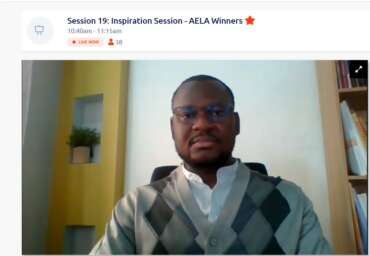[This is the edited transcription of our Director speech at Evidence 2020 online.]
Good morning everyone. Welcome to this session on Enhancing capacities for evidence use. My name is Frejus Thoto, I work for ACED a policy research organization in Benin that builds connection between evidence, policy, and action to improve food and nutrition security. I am also the recipient of the Africa Evidence Leadership Award 2020.
When I was asked to deliver a keynote in relation to enhancing capacities for evidence use, I was overwhelmed by a myriad of topical issues that I could discuss with such a diverse audience at Evidence2020. I initially thought I could engage the participants on what capacities to build, what are the most critical capacity areas that need our attention to improve evidence use, or what are the most effective methods of building capacities to improve evidence use. And then I realized that there is a more fundamental question for which the answer may seem trivial but it is a tricky one.
Whose capacity to build?
When it comes to deciding who to work with to improve evidence use in any development sector the first actor that comes to our mind is the policymaker which is normal. We postulate that by creating a conducive environment for evidence use, policymakers will make informed decisions, develop plans, strategies, and programmes that consider the most accurate available evidence on the subject. As such government officials are trained on how to access and use evidence for decision-making. Some programmes even go further and target evidence producers including researchers, evaluation specialists, and data experts so that the evidence materials they generate are adapted to the needs of decision-makers.
But one stakeholder that is very often overlooked in our efforts to improve evidence use is the implementer. By implementers, I mean those organizations that conduct concrete development activities on the field. They include for example international NGOs and local NGOs that implement projects in development sectors such as education, health, human rights, and agriculture. There are not many initiatives aiming to enhance the capacities of those organizations for evidence use. I guess one reason is that they are just implementers of policies and plans that were developed by policymakers; so, if we make sure those policies and plans are informed by evidence, actions implemented on the field should also be successful.
Why the implementers?
However, the result chain is not that linear. There are at least two arguments that support the need to critically look at implementers in the evidence use system.
- First, those organizations that we consider as implementers are hidden actors who influence policies and plans. When an international NGO is convinced that subsidizing the agricultural sector is a good policy option to support agricultural development in a given country, it may “advocate” for that and in fine influence the national agricultural policy while in the context of the country it may not be a good option. In our work with local governments in Benin, we notice that many of their decisions are informed by reports produced by NGOs or advisory firms. In some cases, the development plans of municipalities are designed by advisory firms that may not necessarily aware of the need to use evidence in the planning process. So those organizations become “policy entrepreneurs” and it is worth knowing the magnitude of their influence on the policymaking system and build their capacities purposively.
- The second reason is that the implementers also make a myriad of decisions that influence the lives of the population. They should choose among many options to operationalize the guidelines given by national policies. For example, an education NGO might need to decide whether they should implement school canteens or not to improve school attendance for children. Having the capacity to use existing evidence will ease those decisions and improve their impact.
So what?
These elements call for a deeper understanding of the different stakeholders and factors that influence the policymakers when they are deciding. I recently published in a blog piece three types of decision-maker: the apparent decision-maker, the constrained decision-maker, and the unwilling decision-maker. I shared the link with the facilitator who can share it with you. So, in addition to understanding that diversity within the decision-makers it is essential that we mainstream the implementers in our programs for evidence use otherwise we may be wrong about whose capacities to build.
This issue raised some critical questions that we need to address. Should we start training implementers on how to access evidence? Should we train them on producing evidence materials such as systematic reviews? Should we link them to researchers and other evidence generators? How can we make sure their influence on policymakers is positive? How can we help them embed evidence use into their routine decision-making process? Providing answers to those questions will advance the field of evidence-informed decision-making.
As a key takeaway from this presentation, I want us to be mindful that in addition to policymakers especially government officials we should also invest in understanding how implementers can influence the final outcome of our EIDM efforts so that we also work with them towards evidence use.
So that’s it. That’s what I wanted to share with you this morning. I look forward to hearing from you. What are your perspectives and thoughts about these issues. We will continue the discussion on this platform, and I am also available online for further engagement.



